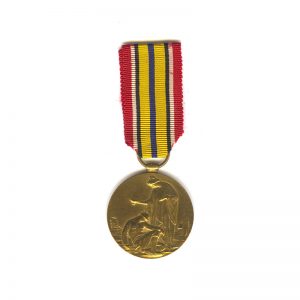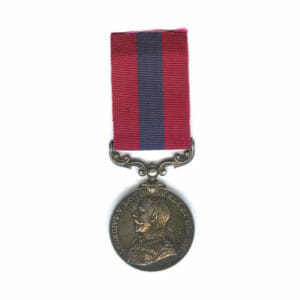Description
Distinguished Conduct Medal, 13027 Private John Fitzpatrick, 1st Battalion South Wales Borderers, for volunteering to lead a daring Bayonet Attack on a Trench NE of Bazentin-le-Petit.
He was later killed in action during a German Attack on 18th April 1918.
Officially impressed: “1-13027 Pte J. Fitzpatrick. 1/S.W. Bord:” Suspension claw slightly loose.
His full citation from the London Gazette, 14th November 1916:.
“For conspicuous gallantry in action. Private Fitzpatrick and another man volunteered to lead a Bayonet Attack.
One reaching a block of wire and buried bayonets, forming a kind of chevaux de frise, they climbed the parapet and removed the obstacles.
They led the attack with great bravery and dash, and utter contempt for danger.”
John Fitzpatrick was born in Wolverhampton. During the war, he served with the 1st Battalion South Wales Borderers, arriving in the France theatre from 11th April 1915.
By the Daily Casualty List of 20th October 1915, he had been admitted for suffering from the effects of Gas Poisoning, which had just been unleashed by the Germans at the same time as he arrived in France.
He served with the battalion as part of the 3rd Brigade, 1st Division on the Somme, from July to November 1916. Then the battalion moved to Bazentin-le-Petit on 20th August.
5 Days later Pte Fitzpatrick would distinguish himself in an attack nearby on the Immediate Trench to the North-East of Bazentin-le-Petit.
Previously an unsuccessful attempt to capture the trench had been made by the Royal Munster Fusiliers on the 24th.
The regimental history expands on his citation,
“Next afternoon (August 25th), however, A Company, now under Captain Inglis, renewed their attack, this time successfully.
A heavy barrage had been put down at intervals with the object of driving the enemy back from the barricade and so clearing the Eastern half of the trench, and at 6.30pm A Company pushed past the barrier and advanced nearly 300 yards, bombing the Germans back.
Serious opposition was offered at a strong point, containing a machine gun which had been largely responsible for the non-success of the earlier attacks. It was captured, however, several prisoners being taken…
The attackers then pushed on, Privates Fitzpatrick and Murphy leading the way with the bayonet. Coming to a block of wire mixed up with bayonets which formed a chevaux de frise they climbed up on to the parapet and removed the obstacle, thus enabling the attack to get forward. C Company had simultaneously attempted to advance across the open against the Western portion of the trench, but this effort failed. A Company, however, captured another 80 yards and consolidated their gains, a trench being dug back from the Westernmost point reached to the old front line.”
Later on in the war, following the renewed German Spring Offensive, Private Fitzpatrick would be killed in action in France on 18th April 1918, now buried in Brown’s Road Military Cemetery, Festubert.
It appears that according to the war diary from the period, he was involved in a gallant defence against a German Attack against the 1st SWB in defence of an area near Route A Keep and Loisne Keep, soon afterwards many messages of congratulations to his battalion for their staunch defence and splendid spirit were received from several Brigade, Divisional and First Army officers and GHQ.





